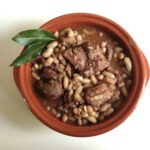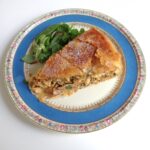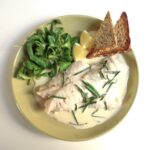 Baby spinach lightly sautéd in olive oil with garlic is one of my favorite ways of preparing this versatile veggie. Add a dash of lemon juice and you have a treat with a southern French edge. In northern France you’re more likely to find spinach prepared with cream or butter, the leaves most often served whole in a generous pile. I use spinach in maybe a dozen ways — in salads, in omelets, in savory tarts and as a side dish, as in the photo.
Baby spinach lightly sautéd in olive oil with garlic is one of my favorite ways of preparing this versatile veggie. Add a dash of lemon juice and you have a treat with a southern French edge. In northern France you’re more likely to find spinach prepared with cream or butter, the leaves most often served whole in a generous pile. I use spinach in maybe a dozen ways — in salads, in omelets, in savory tarts and as a side dish, as in the photo.
Epinards sauté à l’ail / Fresh spinach sautéd with garlic
Yet until today this site has not included a recipe for cooked spinach — an anomaly that is now rectified. Spinach, a popular vegetable in France, has become much easier to prepare with the introduction by supermarkets of prewashed baby leaves. Sometimes I start with spinach straight from the garden, never mind the time it takes to wash away the sand clinging to the leaves and to trim away the thick stems. But often I opt for convenience.
After already writing up and photographing this week’s recipe, I was surprised last weekend to see a feature on spinach in the glossy weekend magazine of Le Monde. This most authoritative of French newspapers reported that spinach was unknown in Europe before the Middle Ages and arrived via Iran and Central Asia around the 12th century during the Crusades. It is considered a spring vegetable here, being most often planted in the autumn, but these days one can find it throughout the year.
Le Monde included some culinary suggestions: a salad of freshly picked young spinach with chopped spring onions, sliced apples and roasted hazelnuts in a lemony sauce; freshly squeezed spinach juice; spinach sautéd quickly with a lump of salted butter; or spinach-stuffed crepes. It noted that spinach historically was served during Lent in various forms, including preserved in clay pots — presumably a forerunner to canned spinach.
Ah, canned spinach. I remember it all too well. It was a dark gray-green and tasted of — well, I’d rather not go there. It’s understandable why this healthy, flavorful veggie acquired a bad rep for a time among children ordered to eat their spinach. In the postwar years, even Hollywood got into the act, summoning American kids to heed Popeye’s famous words: ‘I’m strong to the finish cause I eats me spinach…’
We’ve come a long way. If you like spinach as much as I do, here are more recipes: Mediterranean spinach-feta pie, French pizza with mushrooms and baby spinach, spinach soup with garlic cream, spinach quiche with pine nuts and parmesan, spinach salad with egg and red onion, smoked salmon omelet with spinach, spinach salad with strawberries and pine nuts, oysters gratinéed with spinach and spinach salad with pancetta.
Happy cooking.

 This is a fish story, the upshot of which is a dish of baked sea bream with a delicate lime-flavored sauce. It started two weeks ago when I went to the market and my fishmonger wasn’t there — he’d apparently gone on vacation during the French school holidays. So I wandered through the market and found another fish stand with a remarkably beautiful display. In the middle was a large red fish that looked like a giant goldfish.
This is a fish story, the upshot of which is a dish of baked sea bream with a delicate lime-flavored sauce. It started two weeks ago when I went to the market and my fishmonger wasn’t there — he’d apparently gone on vacation during the French school holidays. So I wandered through the market and found another fish stand with a remarkably beautiful display. In the middle was a large red fish that looked like a giant goldfish. Although I had never encountered pageot before, I bought two, brought them home and looked it up: red sea bream. Fine. The next day I set to work for my guest. I coated the fish lightly with olive oil, inserted a couple of lime bits in the cavity and oven-baked it whole. While it was baking, I chopped and steamed a leek and made a sauce of cream, lime zest and lime juice. When the fish was done, I set it on a bed of leeks and drizzled it with the sauce. On the side I served steamed baby zucchini. My guest was delighted.
Although I had never encountered pageot before, I bought two, brought them home and looked it up: red sea bream. Fine. The next day I set to work for my guest. I coated the fish lightly with olive oil, inserted a couple of lime bits in the cavity and oven-baked it whole. While it was baking, I chopped and steamed a leek and made a sauce of cream, lime zest and lime juice. When the fish was done, I set it on a bed of leeks and drizzled it with the sauce. On the side I served steamed baby zucchini. My guest was delighted. To give you an idea of the wealth of fish on offer at this stand, here’s another photo. On display in just this tiny corner of the stand are daurade royale (gilthead sea bream), merlan (whiting), limande sole (lemon sole), encornets (squid), seiche (cuttlefish), tourteaux (crab), praires (clams), rascasse (scorpion fish), colinot (hake), colinot friture (small hake for frying) and bar d’élevage (farmed sea bass). This is what makes it so delightful to be a culinary-minded person in Paris, even in a time of lockdown.
To give you an idea of the wealth of fish on offer at this stand, here’s another photo. On display in just this tiny corner of the stand are daurade royale (gilthead sea bream), merlan (whiting), limande sole (lemon sole), encornets (squid), seiche (cuttlefish), tourteaux (crab), praires (clams), rascasse (scorpion fish), colinot (hake), colinot friture (small hake for frying) and bar d’élevage (farmed sea bass). This is what makes it so delightful to be a culinary-minded person in Paris, even in a time of lockdown. If you’ve ever been to Paris, you will most likely have encountered a croque-monsieur, the classic French grilled sandwich of ham, cheese and a creamy sauce. No one makes them at home because they’re served on virtually every street corner, at virtually every café. But with the cafés closed now and snow drifting down the other day, I decided to give it a go. And being in a non-traditional mood, I made an open-faced version on rustic country bread.
If you’ve ever been to Paris, you will most likely have encountered a croque-monsieur, the classic French grilled sandwich of ham, cheese and a creamy sauce. No one makes them at home because they’re served on virtually every street corner, at virtually every café. But with the cafés closed now and snow drifting down the other day, I decided to give it a go. And being in a non-traditional mood, I made an open-faced version on rustic country bread. When I decided to make a croque, my first step was go down the street to a bakery called
When I decided to make a croque, my first step was go down the street to a bakery called  I like the challenge of going into the kitchen and creating a dish with whatever ingredients happen to be around. So the other day I made a zingy salad from a couple handfuls of lettuce leaves bathed in a garlicky mustard vinaigrette, topped with croutons straight out of the oven. I didn’t exactly create it because I’ve been making this salad for years. The pleasure was in finding the fridge nearly bare and still being able to produce a tasty lunch.
I like the challenge of going into the kitchen and creating a dish with whatever ingredients happen to be around. So the other day I made a zingy salad from a couple handfuls of lettuce leaves bathed in a garlicky mustard vinaigrette, topped with croutons straight out of the oven. I didn’t exactly create it because I’ve been making this salad for years. The pleasure was in finding the fridge nearly bare and still being able to produce a tasty lunch. A couple years back I was served this intensely flavorful French dish of lamb and beans on a cold winter’s evening by an English friend who happens to be a superlative cook. Snow was drifting down outside her cottage as a maddeningly delicious aroma wafted from the kitchen — rosemary, thyme, bacon, garlic, tomato and lamb. When I asked for the recipe, she said she didn’t have one — she’d been making it so long that she did it by instinct.
A couple years back I was served this intensely flavorful French dish of lamb and beans on a cold winter’s evening by an English friend who happens to be a superlative cook. Snow was drifting down outside her cottage as a maddeningly delicious aroma wafted from the kitchen — rosemary, thyme, bacon, garlic, tomato and lamb. When I asked for the recipe, she said she didn’t have one — she’d been making it so long that she did it by instinct. This is a French take on that cold-weather classic, split pea soup. A traditional dish in Alsace, where it is known as as erbsesupp, it has a smoky flavor, imparted by bacon, while a drizzle of cream lends a soothing touch. It’s hearty enough to stand on its own as a lunch dish, perhaps accompanied by melted cheese on toast or some cold cuts. And it can be made in less than an hour.
This is a French take on that cold-weather classic, split pea soup. A traditional dish in Alsace, where it is known as as erbsesupp, it has a smoky flavor, imparted by bacon, while a drizzle of cream lends a soothing touch. It’s hearty enough to stand on its own as a lunch dish, perhaps accompanied by melted cheese on toast or some cold cuts. And it can be made in less than an hour. This festive chocolate-pear dessert is the brainchild of the chef
This festive chocolate-pear dessert is the brainchild of the chef  Preparation is fun. Pear halves are sautéd in butter and sugar until they caramelize and are meltingly tender. The ganache, a classic of French cuisine, is a mixture of high-quality dark chocolate and warm cream, stirred together until they form a smooth, rich sauce. The dessert is refrigerated until set, and may then be served sliced — or whole, to achieve a Yule log effect.
Preparation is fun. Pear halves are sautéd in butter and sugar until they caramelize and are meltingly tender. The ganache, a classic of French cuisine, is a mixture of high-quality dark chocolate and warm cream, stirred together until they form a smooth, rich sauce. The dessert is refrigerated until set, and may then be served sliced — or whole, to achieve a Yule log effect. The site now counts more than 400 recipes — phew! — and I have a list as long as my arm of recipes still to come. Most I have posted with a blog entry, but every so often I slip one in surreptitiously for inclusion in the site’s
The site now counts more than 400 recipes — phew! — and I have a list as long as my arm of recipes still to come. Most I have posted with a blog entry, but every so often I slip one in surreptitiously for inclusion in the site’s  And so I leave you, dear readers, with hopes that 2021 will be a year of peace, joy and a return to life as we’ve known it. The Everyday French Chef will be on vacation on New Year’s Day, with my next post arriving on Friday, Jan. 8. Until then, here’s wishing you good health, happy holidays — and happy cooking.
And so I leave you, dear readers, with hopes that 2021 will be a year of peace, joy and a return to life as we’ve known it. The Everyday French Chef will be on vacation on New Year’s Day, with my next post arriving on Friday, Jan. 8. Until then, here’s wishing you good health, happy holidays — and happy cooking. Pastilla, a splendid savory pie, is worth a thought for a festive dinner as we gallop toward the holiday season. Crisp pastry encases chicken and almonds simmered to melt-in-your-mouth tenderness in exotic spices. The pie is sprinkled with powdered sugar to lend a seductive sweetness that will have your guests asking for more. But beware — making pastilla is a bit of a production. In other words, this is not an everyday dish
Pastilla, a splendid savory pie, is worth a thought for a festive dinner as we gallop toward the holiday season. Crisp pastry encases chicken and almonds simmered to melt-in-your-mouth tenderness in exotic spices. The pie is sprinkled with powdered sugar to lend a seductive sweetness that will have your guests asking for more. But beware — making pastilla is a bit of a production. In other words, this is not an everyday dish Pastilla was traditionally made with pigeon, but these days chicken is generally used. In France, pastilla is often served as small individual pies. But for a festive occasion like Christmas, New Year’s or Hanukah, a large pie makes an impressive presentation. One pie will serve 10 as a starter or 6-8 as a main dish. Preparation takes several hours, but if you’ve got the time and the patience, it’s well worth the effort.
Pastilla was traditionally made with pigeon, but these days chicken is generally used. In France, pastilla is often served as small individual pies. But for a festive occasion like Christmas, New Year’s or Hanukah, a large pie makes an impressive presentation. One pie will serve 10 as a starter or 6-8 as a main dish. Preparation takes several hours, but if you’ve got the time and the patience, it’s well worth the effort. Paris bistros often serve fish in a lemony cream sauce that I’ve never seen served in a French home. Why not, one wonders? It proved remarkably easy to prepare when I tried it out in my kitchen the other day after scouting around online for tips. And the beauty of this sauce is that it may be served over any type of filleted fish — cod, haddock, salmon, sea bass, you name it — and would also be delicious over scallops, lobster or other shellfish.
Paris bistros often serve fish in a lemony cream sauce that I’ve never seen served in a French home. Why not, one wonders? It proved remarkably easy to prepare when I tried it out in my kitchen the other day after scouting around online for tips. And the beauty of this sauce is that it may be served over any type of filleted fish — cod, haddock, salmon, sea bass, you name it — and would also be delicious over scallops, lobster or other shellfish. The sauce is a mixture of cream, butter, lemon juice, salt, pepper and fresh herbs. Chives are traditional, but you can branch out and use the herb or your choice, for example dill, tarragon, cilantro, thyme, parsley or chervil. Unlike sauces involving egg yolks (
The sauce is a mixture of cream, butter, lemon juice, salt, pepper and fresh herbs. Chives are traditional, but you can branch out and use the herb or your choice, for example dill, tarragon, cilantro, thyme, parsley or chervil. Unlike sauces involving egg yolks ( A pumpkin soufflé might be just the ticket this year for those of us who are under lockdown but still want to celebrate Thanksgiving. Here in Paris, where the lockdown is in effect until at least Dec. 1, a friend and I who give a gala dinner every year have begun thinking about how to get creative when gatherings are essentially banned. For the moment, we’re planning a twosome — meaning roast turkey with stuffing is off the menu. What is to be done?
A pumpkin soufflé might be just the ticket this year for those of us who are under lockdown but still want to celebrate Thanksgiving. Here in Paris, where the lockdown is in effect until at least Dec. 1, a friend and I who give a gala dinner every year have begun thinking about how to get creative when gatherings are essentially banned. For the moment, we’re planning a twosome — meaning roast turkey with stuffing is off the menu. What is to be done? My role as the token American was supposed to be simple — to make cranberry sauce and bring it to Blanc’s table in Vonnas, just south of Burgundy. At the last minute, I was asked to provide cornbread as well (oops, not my specialty). When we sat down, Georges Blanc produced a roast turkey unlike any I’d tasted before — stuffed with veal, pork, walnuts and thyme — and a fabulous
My role as the token American was supposed to be simple — to make cranberry sauce and bring it to Blanc’s table in Vonnas, just south of Burgundy. At the last minute, I was asked to provide cornbread as well (oops, not my specialty). When we sat down, Georges Blanc produced a roast turkey unlike any I’d tasted before — stuffed with veal, pork, walnuts and thyme — and a fabulous 

